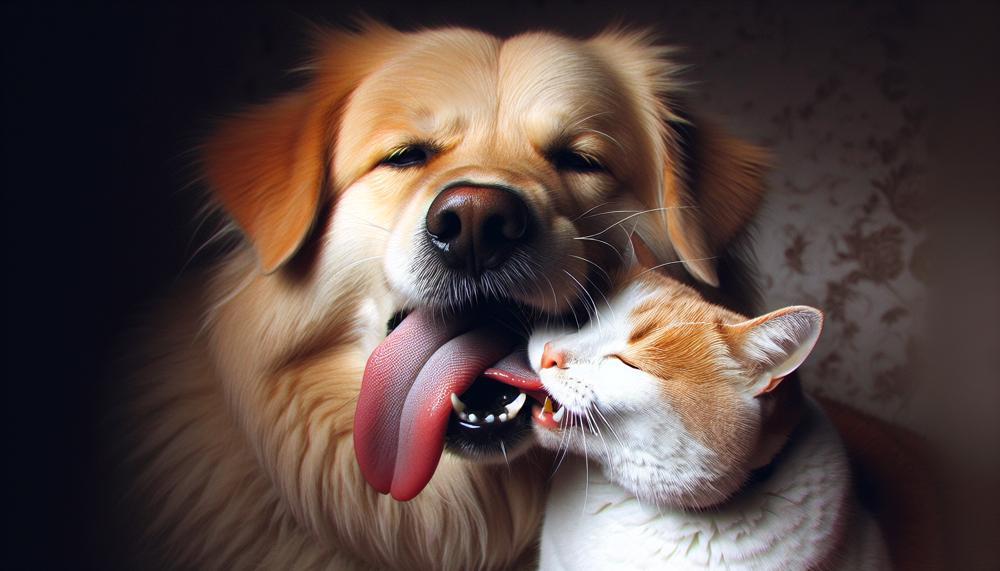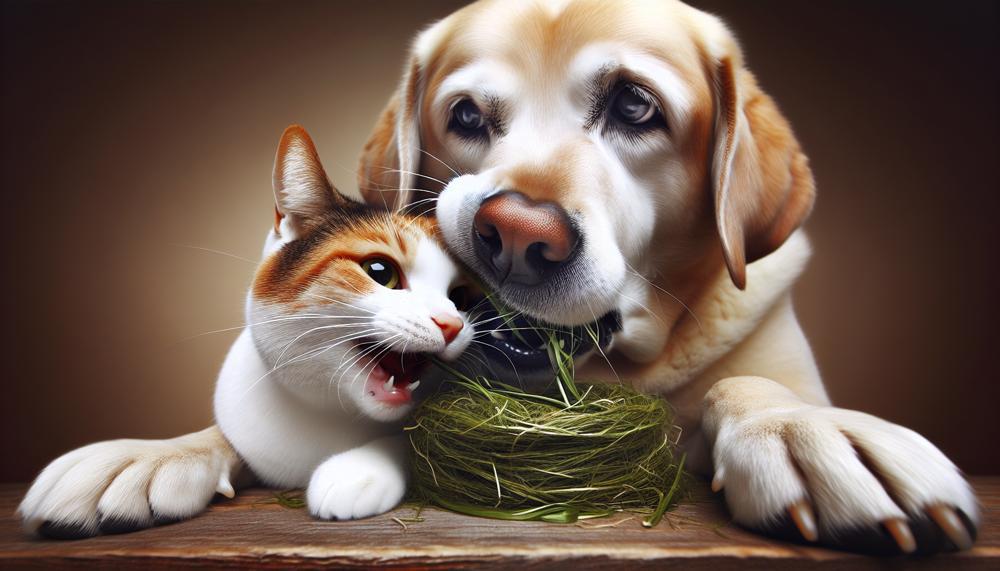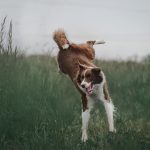As a dog owner, have you ever observed your four-legged companion nibbling on your cat? If so, don’t worry, you’re not alone. Dogs and cats have a complex relationship that can involve playful or not-so-playful nibbling. But what drives dogs to do this? And should we be concerned about it?
In this blog post, we’ll delve into the reasons behind why dogs nibble on cats and how it affects their dynamic. We’ll also explore if this behavior is normal and provide tips for managing it. Here are some key points to keep in mind:
- Dogs may nibble on cats as a way of playing or asserting dominance.
- This behavior may also stem from their innate instincts as predators.
- It’s crucial to supervise their interactions and intervene if necessary.
- Creating a positive bond between your dog and cat can help decrease any potential nibbling.
- Seeking professional assistance may be necessary if the behavior becomes aggressive.
So, let’s embark on our journey to uncover the mystery of why our beloved canines sometimes can’t resist giving our feline friends a little nibble.
Your Dog Grooms Your Cat
Table of Contents
- 1 Your Dog Grooms Your Cat
- 2 Your Dog Has a Strong Prey Drive
- 3 Your Dog is Trying to Form a Bond with Your Cat
- 4 It’s an Instinctive Behavior
- 5 Your Dog is Trying to Dominate Your Cat
- 6 It is a Sign of Affection
- 7 Your Dog is Jealous
- 8 Your Dog has a Strong Herding Instinct
- 9 Your Dog is Stressed or Anxious
- 10 How to Get Your Dog to Stop Nibbling On Your Cat?
- 11 Conclusion
Dogs grooming cats is a behavior that comes naturally to them, serving various purposes like building a strong bond, maintaining hygiene, and communicating with each other. This behavior is commonly observed in households where dogs and cats live together, and it reflects a deep connection between the two animals.
| Dogs groom cats to build a strong bond: | As social creatures, both dogs and cats engage in mutual grooming to strengthen their relationships. By grooming each other, they are displaying trust and affection towards one another. |
| Dogs groom cats for cleanliness: | In certain cases, dogs may groom cats to help them clean themselves if they are unable to do so. This could be due to old age, illness, or injury. |
| Grooming serves as a means of communication between dogs and cats: | Aside from bonding, grooming can also act as a form of communication between dogs and cats. It can convey a sense of dominance or submission, as well as serve as a greeting or expression of love. |
| Nibbling is a learned behavior from puppies: | Puppies use their mouths to explore their surroundings and show affection towards each other. As they grow older, this behavior may carry over into their interactions with other animals, like cats. |
| Dogs may groom cats to remove parasites: | If a cat has a flea infestation, dogs may nibble on them to get rid of the parasites from their fur. This behavior is instinctive and helps keep both animals clean and healthy. |
| Positive reinforcement is recommended for correcting unwanted nibbling behavior: | Instead of using punishment methods, it is best to use positive reinforcement techniques when training dogs not to nibble on cats. This can help strengthen their bond and prevent aggression between the two animals. |
| Nibbling can lead to a lasting friendship between dogs and cats: | Overall, nibbling between dogs and cats is usually seen as a positive behavior that can result in a strong and long-lasting friendship between the two animals. However, it is important to be cautious if the cat shows any signs of discomfort or if there is flea treatment on their fur. |
Your Dog Has a Strong Prey Drive
Dogs with a strong prey drive are often driven by their instinctual desire to hunt and chase small animals. This can make them view cats as potential prey and trigger aggressive or predatory behavior towards them. As a result, it is vital for dog owners to be aware of their dog’s prey drive and take necessary precautions when introducing them to cats.

In addition, some dogs may also exhibit territorial aggression towards cats due to their protective nature over their living space. They may see the presence of a cat as a threat and react aggressively towards them. On the other hand, some dogs may simply be afraid of cats, which can also influence their behavior towards them.
As a responsible dog owner, it is important to closely monitor your dog’s interactions with cats and intervene if necessary. Being able to recognize signs of aggression such as growling, barking, or stiff body posture can help you anticipate any negative behavior towards cats. Furthermore, understanding your dog’s body language can also give you insight into their emotions and reactions towards cats.
By keeping a close eye on your dog’s behavior and taking necessary precautions, you can prevent any potential harm to both your dog and the cat. It is also beneficial to gradually introduce your dog to cats in a controlled environment and seek professional help if needed.
Your Dog is Trying to Form a Bond with Your Cat
Nibbling is one of the ways that dogs express their affection towards cats. However, it’s crucial to note that nibbling can also be a sign of play or dominance, so it’s important to pay attention to your dog’s body language and the context of the situation to determine if they are trying to bond with your cat through nibbling.
Here are some signs that your dog may exhibit when trying to bond with your cat through nibbling:
- Delicate and controlled nibbling: If your dog gently nibbles on your cat without any signs of aggression or roughness, it could be a display of affection. This type of nibbling is usually slow and controlled, and your dog may even lick or groom your cat after.
- Relaxed body language: Dogs who are attempting to form a bond with cats will often have relaxed body language and may even wag their tails while nibbling. This shows that they are not trying to dominate or show aggression towards the cat.
- Social grooming behavior: Dogs often use grooming as a way to bond with other animals, including cats. If your dog is gently nibbling on your cat’s fur, it could be their way of showing affection and forming a bond.
- Positive interactions: If your dog and cat engage in playful activities together and nibbling is part of their play, it’s likely a sign of a positive bond between them. Playful interactions between dogs and cats can help strengthen their relationship and build a sense of trust and companionship.
It’s important to keep in mind that every dog is unique, and some may display their affection towards cats in different ways. Therefore, it’s essential to pay close attention to your dog’s behavior and body language to determine if they are attempting to bond with your cat through nibbling.
It’s an Instinctive Behavior
It’s an innate behavior for some dogs to want to nibble on cats, as they are predators or herding dogs by nature. This can be attributed to their level of prey drive or lack of socialization. As a pet owner, it’s crucial to be aware of these tendencies and take necessary precautions to ensure the safety of your cat.
It’s common for dogs with a strong prey drive to see cats as potential prey, due to their instincts as predators. This can lead to them trying to nibble or chase after cats, even if they are not actively trying to harm them. Similarly, herding dogs may also display this behavior as they are used to rounding up and controlling smaller animals.
In such cases, it’s important for pet owners to recognize and address these behaviors early on. This can be achieved through proper socialization and training from a young age. Teaching your dog positive reinforcement techniques and providing them with appropriate outlets for their energy can also help redirect their focus away from cats.
Moreover, it’s important to supervise interactions between your dog and cat closely, especially if your dog has a high prey drive. This will not only ensure the safety of your cat but also prevent any potential harm that may occur due to misunderstandings between the two animals.
As pet owners, it’s our responsibility to understand and address our dog’s natural tendencies in a way that ensures the safety and well-being of all animals involved.
Your Dog is Trying to Dominate Your Cat
One method to determine if your furry companion is asserting dominance over their feline counterpart through nibbling is by closely observing their body language and the frequency of this behavior. It is also important to take note of how your cat responds to your dog’s nibbling. If you spot any worrisome behavior, it is crucial to intervene and train your dog not to exhibit dominant tendencies towards your cat.
As much as we love our pets, it is important to recognize that they are still animals with their own instincts and behaviors. Sometimes, this can lead to conflicts between different species in a household. In this case, it may seem like your dog is trying to dominate your cat through nibbling, but there could be other underlying factors at play.
For example, your dog may be exhibiting signs of fear or discomfort around your cat, leading them to assert dominance as a way of protecting themselves. It could also be a result of a lack of proper socialization or training on your dog’s part. By understanding the root cause of this behavior, you can better address it and create a harmonious environment for all your pets.
Furthermore, just like us, animals can also have different personalities and preferences. Your dog may simply enjoy playing or interacting with your cat in this manner, and it does not necessarily mean they are trying to assert dominance. However, it is essential to monitor their interactions and ensure that both pets are comfortable and happy in each other’s company.
It is a Sign of Affection
Nibbling is a common behavior in canines that can have diverse interpretations, including indications of fondness towards their feline counterparts. However, it is essential to comprehend the context and underlying factors to determine if the nibbling conduct is truly a sign of affection or something else.
Table Format:
| Possible Reasons for Nibbling | Explanation |
| Grooming Purposes | Nibbling can be a way for dogs to groom their feline friends, similar to how they would groom another dog. |
| Playfulness/Excitement | Dogs may nibble on cats as a form of play or excitement, especially with high-energy breeds. |
| Prey Drive | Some dog breeds may have a strong prey drive that leads them to nibble on cats, mistaking them for small prey animals. |
| Jealousy/Attention-Seeking | In some cases, dogs may nibble on cats out of jealousy or to seek attention from their owners. |
| Dominance | Nibbling can also be a way for dogs to assert dominance over their territory or initiate play with the cat. |
| Sign of Affection | Grooming can be a natural behavior for dogs and may be a sign of affection or establishing social hierarchy. |
To determine if your canine’s nibbling behavior towards your feline is an indication of affection, it is crucial to observe their body language and behavior. Playful nibbling will typically involve wagging tails, relaxed body language, and may even include playful barks or growls. On the other hand, aggressive nibbling will involve tense body language, raised fur, and possibly snarling or baring teeth.
Ensuring proper socialization and training for your dog can also help prevent and address any aggressive or dominant behaviors towards your cat. Providing separate spaces and supervision for your pets can also help prevent any potential conflicts.
Environmental enrichment, such as toys and puzzles, can also keep dogs mentally stimulated and less likely to engage in negative behaviors.
Your Dog is Jealous
There are numerous indications that may suggest that your dog is showing jealous tendencies towards your cat. These include an excessive desire for attention, aggressive actions towards the cat, acts of guarding and protecting, as well as shifts in their behavior towards you.
Recognizing and addressing these signs can aid in fostering a harmonious relationship between your beloved pets.
- Jealousy is a complex emotion that can manifest in various forms, including in our canine companions. Dogs often have strong attachments to their owners and can experience feelings of jealousy when they perceive a threat to their bond. This can lead to behaviors that may seem unusual or concerning to us as pet owners.
- One of the most common signs of jealousy in dogs is excessive attention-seeking. If your dog suddenly becomes more demanding of your time and affection when you are giving attention to your cat, it could be a sign of jealousy. They may try to interrupt interactions between you and your cat or even act out aggressively towards the feline.
- Another clear indication of jealousy is when your dog starts exhibiting aggressive behavior towards your cat. This can range from growling and barking to even physically attacking the cat. It’s essential to address this behavior immediately before it escalates and causes harm to either pet.
- In addition to their behavior towards the cat, dogs may also show guarding behaviors when they are feeling jealous. This could involve guarding their food, toys, or even their owners from the cat. They may also become possessive of certain spaces and objects in the house.
- Keep an eye out for any changes in your dog’s behavior towards you. If they become more distant or exhibit signs of anxiety, it could be a result of them feeling jealous of the attention you are giving to your cat.
Understanding and addressing these signs of jealousy can help maintain a peaceful coexistence between your pets. Providing equal love and attention to both your dog and cat can also help alleviate any feelings of jealousy your dog may be experiencing.
Your Dog has a Strong Herding Instinct
The strong herding instinct of dogs, a natural behavior that has been bred into them for centuries, can impact their tendency to nibble on other animals, such as cats, in several ways. This deeply ingrained instinct compels dogs to gather, control, and safeguard other animals, which can manifest as chasing, nipping, and herding. This behavior is often triggered by the presence of unfamiliar animals or objects in a dog’s territory, their natural drive to hunt prey, and their pack mentality.
It is essential to understand the origins of this innate drive. Bred into many dog breeds for centuries, this instinct was once vital for their survival as working animals. Herding dogs were responsible for gathering and controlling livestock, protecting them from predators, and directing them towards specific destinations. This intense focus and drive to herd is deeply ingrained in their DNA and continues to influence their behavior even in modern times.
However, this instinct can also cause issues when living with other animals in a household setting. Dogs with a strong herding instinct may see smaller animals like cats as potential prey or competition for resources.
They may try to control or “herd” these animals by nipping at their heels or chasing them. This behavior can be problematic and even dangerous if not properly managed.
To address this issue, pet owners must understand the various triggers that can activate their dog’s herding instinct. One common trigger is the presence of unfamiliar animals or objects in a dog’s territory. This can cause them to become territorial and feel the need to protect their space by herding any perceived intruders.
Additionally, a dog’s natural prey drive can also contribute to their herding behavior towards other animals. This drive is especially strong in breeds with a history of hunting and chasing prey, such as terriers and hounds. In these cases, the dog may see smaller animals as potential prey to be controlled and captured.
Dogs are pack animals, and their instinct is to maintain a social hierarchy within their group. In a household setting, this can manifest as herding behavior towards other animals that they perceive as lower in the hierarchy. This can be particularly problematic if the dog sees themselves as the dominant member of the household and tries to assert control over other animals.
Your Dog is Stressed or Anxious
When it comes to our furry companions, we all want them to be happy and healthy. However, sometimes our dogs may exhibit physical and behavioral signs that indicate they are stressed or anxious. This can manifest in various ways, such as excessive barking, panting, pacing, drooling, trembling, hiding, or destructive behaviors. As pet owners, it is important to identify the triggers for these behaviors and take necessary steps to reduce their stress levels.
But what can cause our beloved dogs to feel stressed or anxious?
It could be a variety of factors, such as loud noises or unfamiliar environments. Each dog is unique and may have different triggers that induce this type of behavior. As pet owners, it is our responsibility to understand and address these triggers in order to create a safe and comfortable environment for our furry friends.
How to Get Your Dog to Stop Nibbling On Your Cat?
| Observe and redirect behavior: | Keep a close eye on your dog’s behavior towards your cat. If you notice any nibbling, redirect their attention to a toy or treat. |
| Offer suitable chew toys: | Dogs have a natural instinct to chew, so providing them with appropriate chew toys can satisfy this urge and prevent them from nibbling on your cat. |
| Train your dog: | Teaching your dog to have good impulse control can help prevent rough nibbling. Use the “leave it” command and reward them when they obey. |
| Consult with a vet: | Parasite prevention is crucial for promoting a harmonious coexistence between pets. Regularly consult with a veterinarian for the best prevention methods. |
| Avoid punishment: | Punishment can cause stress and fear in dogs, resulting in more unwanted behavior. Instead, use positive reinforcement to correct unwanted nibbling behaviors. |
| Use separation when needed: | If the nibbling causes discomfort or aggression, separate the animals until they are calm and can interact peacefully. |
| Encourage positive interactions: | Promote a harmonious relationship between your dog and cat by encouraging positive interactions, such as playing and snuggling together. |
In conclusion, preventing dogs from nibbling on cats requires constant monitoring, training, providing suitable outlets for their chewing needs, and seeking professional advice from a veterinarian. Punishment should be avoided at all costs as it can lead to more unwanted behavior. With proper care and attention, dogs and cats can coexist peacefully and even form a strong bond through nibbling.
Also Read: Dog Whining In Crate All Of A Sudden
Conclusion
In summary, the act of a dog nibbling on a cat may initially cause concern, but it is a behavior that can be interpreted in various ways. It could be a playful gesture, an expression of affection, or even a display of dominance.
By delving into the reasons behind this behavior and closely observing their interactions, you can foster a positive relationship between your furry companions.
With proper training, supervision, and attention to both pets’ needs, you can create a harmonious household where they can peacefully coexist.






